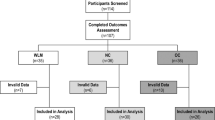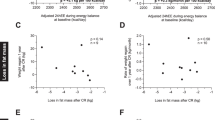Abstract
Background:
African American (AA) women have been shown to lose less weight than Caucasian women in response to behavioral interventions. Our objective was to examine adherence to intervention and metabolic factors that may explain this difference.
Design and subjects:
We examined longitudinal changes in body weight and energy expenditure (EE), and objective assessment of physical activity (PA) and energy intake (EI) during 6 months of a weight-loss intervention program, including prescribed calorie restriction and increased PA in 66 Caucasian and 39 AA severely obese women. Comparisons were also made in 25 Caucasian and 25 AA women matched for initial body weight.
Results:
The AA women lost 3.6 kg less weight than Caucasian women. Total daily EE (TDEE) and resting metabolic rate (RMR) adjusted for fat free mass (FFM) were significantly lower in the AA women, whereas the decrease in RMR in response to weight loss was greater in Caucasian women. Adherence to the prescribed PA and change in PA in response to intervention were similar in AA and Caucasian women. Prescribed EI (1794±153 and 1806±153 kcal per day) and measured EI during intervention (2591±371 vs 2630±442 kcal per day) were nearly identical in matched AA and Caucasian women. However, the AA women lost significantly less body weight due to lower energy requirements (2924±279 vs 3116±340 kcal per day; P<0.04), resulting in a lower energy deficit (333±210 vs 485±264 kcal per day).
Conclusion:
Adherence to the behavioral intervention was similar in AA and Caucasian women. However, neglecting to account for the lower energy requirements in AA women when calculating the energy prescription resulted in a lower level of calorie restriction and, hence, less body weight loss. Therefore, to achieve similar weight loss in AA women, the prescribed caloric restriction cannot be based on weight alone, but must be lower than in Caucasians, to account for lower energy requirements.
This is a preview of subscription content, access via your institution
Access options
Subscribe to this journal
Receive 12 print issues and online access
$259.00 per year
only $21.58 per issue
Buy this article
- Purchase on Springer Link
- Instant access to full article PDF
Prices may be subject to local taxes which are calculated during checkout



Similar content being viewed by others
References
Cossrow N, Falkner B . Race/ethnic issues in obesity and obesity-related comorbidities. J Clin Endocrinol Metab 2004; 89: 2590–2594.
Okosun IS . Ethnic differences in the risk of type 2 diabetes attributable to differences in abdominal adiposity in American women. J Cardiovasc Risk 2000; 7: 425–430.
Ike SO . Racial differences in rates of type 2 diabetes in American women: how much is due to differences in overall adiposity? Ethnicity Health 2001; 6: 27–34.
Finkelstein EA, Khavjou OA, Mobley LR, Haney DM, Will JC . Racial/ethnic disparities in coronary heart disease risk factors among WISEWOMAN enrollees. J Womens Health (Larchmt) 2004; 13: 503–518.
Mensah GA, Mokdad AH, Ford ES, Greenlund KJ, Croft JB . State of disparities in cardiovascular health in the United States. Circulation 2005; 111: 1233–1241.
Stevens J . Obesity and mortality in Africans-Americans. Nutr Rev 2000; 58: 346–353.
Paeratakul S, Lovejoy JC, Ryan DH, Bray GA . The relation of gender, race and socioeconomic status to obesity and obesity comorbidities in a sample of US adults. Int J Obes Relat Metab Disord 2002; 26: 1205–1210.
McTigue KM, Harris R, Hemphill B, Lux L, Sutton S, Bunton AJ et al. Screening and interventions for obesity in adults: summary of the evidence for the U.S. Preventive Services Task Force. Ann Intern Med 2003; 139: 933–949.
Kumanyika SK, Obarzanek E, Stevens VJ, Hebert PR, Whelton PK . Weight-loss experience of black and white participants in NHLBI- sponsored clinical trials. Am J Clin Nutr 1991; 53: 1631S–1638S.
Hollis JF, Gullion CM, Stevens VJ, Brantley PJ, Appel LJ, Ard JD et al. Weight loss during the intensive intervention phase of the weight-loss maintenance Trial. Am J Prevent Med 2008; 35: 118–126.
West DS, Elaine Prewitt T, Bursac Z, Felix HC . Weight loss of Black, White, and Hispanic men and women in the diabetes prevention program. Obesity 2008; 16: 1413–1420.
Subar AF, Kipnis V, Troiano RP, Midthune D, Schoeller DA, Bingham S et al. Using intake biomarkers to evaluate the extent of dietary misreporting in a large sample of adults: The OPEN Study. Am J Epidemiol 2003; 158: 1–13.
Champagne CM, Bray GA, Kurtz AA, Monteiro JB, Tucker E, Volaufova J et al. Energy intake and energy expenditure: a controlled study comparing dietitians and non-dietitians. J Am Diet Assoc 2002; 102: 1428–1432.
Pietilainen KH, Korkeila M, Bogl LH, Westerterp KR, Yki-Jarvinen H, Kaprio J et al. Inaccuracies in food and physical activity diaries of obese subjects: complementary evidence from doubly labeled water and co-twin assessments. Int J Obes (Lond) 2010; 34: 437–445.
Racette SB, Das SK, Bhapkar M, Hadley EC, Roberts SB, Ravussin E et al. Approaches for quantifying energy intake and %calorie restriction during calorie restriction interventions in humans: the multicenter CALERIE study. Am J Physiol Endocrinol Metab 2012; 302: E441–E448.
de Jonge L, DeLany JP, Nguyen T, Howard J, Hadley EC, Redman LM et al. Validation study of energy expenditure and intake during calorie restriction using doubly labeled water and changes in body composition. Am J Clin Nutr 2007; 85: 73–79.
Jakicic JM, Marcus M, Gallagher KI, Randall C, Thomas E, Goss FL et al. Evaluation of the SenseWear Pro Armband to assess energy expenditure during exercise. Med Sci Sports Exerc 2004; 36: 897–904.
Mackey DC, Manini TM, Schoeller DA, Koster A, Glynn NW, Goodpaster BH et al. Validation of an armband to measure daily energy expenditure in older adults. J Gerontol Ser A Biol Sci Med Sci 2011; 66A: 1108–1113.
DeLany JP, Kelley DE, Hames KC, Jakicic JM, Goodpaster BH . Effect of physical activity on weight loss, energy expenditure and energy intake during diet induced weight loss. Obesity 2013. e-pub ahead of print 26 June 2013 doi:10.1002/oby.20525.
Geissler CA, Aldouri MS . Racial differences in the energy cost of standardised activities. Ann Nutr Metab 1985; 29: 40–47.
Hunter GR, Weinsier RL, Darnell BE, Zuckerman PA, Goran MI . Racial differences in energy expenditure and aerobic fitness in premenopausal women1. Am J Clin Nutr 2000; 71: 500–506.
Jakicic JM, Wing RR . Differences in resting energy expenditure in African-American vs Caucasian overweight females. Int J Obes Relat Metab Disord 1998; 22: 236–242.
Kushner RF, Racette SB, Neil K, Schoeller DA . Measurement of physical activity among black and white obese women. Obes Res 1995; 3 (Suppl 2): 261s–265s.
Sharp TA, Bell ML, Grunwald GK, Schmitz KH, Sidney S, Lewis CE et al. Differences in resting metabolic rate between White and African-American young adults. Obes Res 2002; 10: 726–732.
Weyer C, Snitker S, Bogardus C, Ravussin E . Energy metabolism in African Americans: potential risk factors for obesity. Am J Clin Nutr 1999; 70: 13–20.
Blanc S, Schoeller DA, Bauer D, Danielson ME, Tylavsky F, Simonsick EM et al. Energy requirements in the eighth decade of life. Am J Clin Nutr 2004; 79: 303–310.
Carpenter WH, Fonong T, Toth MJ, Ades PA, Calles-Escandon J, Walston JD et al. Total daily energy expenditure in free-living older African-Americans and Caucasians. Am J Physiol 1998; 274 (1 Pt 1): E96–101.
Weinsier RL, Hunter GR, Zuckerman PA, Redden DT, Darnell BE, Larson DE et al. Energy expenditure and free-living physical activity in black and white women: comparison before and after weight loss. Am J Clin Nutr 2000; 71: 1138–1146.
Blanc S, Schoeller D, Kemnitz J, Weindruch R, Colman R, Newton W et al. Energy expenditure of rhesus monkeys subjected to 11 years of dietary restriction. J Clin Endocrinol Metab 2003; 88: 16–23.
Benedict FG, Roth P . Effects of a prolonged reduction in diet on 25 men: I. influence on basal metabolism and nitrogen excretion. Proc Natl Acad Sci USA 1918; 4: 149–152.
Leibel RL, Rosenbaum M, Hirsch J . Changes in energy expenditure resulting from altered body weight. N Engl J Med 1995; 332: 621–628.
Tremblay A, Chaput J-P . Adaptive reduction in thermogenesis and resistance to lose fat in obese men. Br J Nutr 2009; 102: 488–492.
Heilbronn LK, de Jonge L, Frisard MI, DeLany JP, Larson-Meyer DE, Rood J et al. Effect of 6-month calorie restriction on biomarkers of longevity, metabolic adaptation, and oxidative stress in overweight individuals: a randomized controlled trial. JAMA 2006; 295: 1539–1548.
Goran MI, Poehlman ET . Endurance training does not enhance total energy expenditure in healthy elderly persons. Am J Physiol 1992; 263 (5 Pt 1): E950–E957.
Wang X, Nicklas BJ . Acute impact of moderate-intensity and vigorous-intensity exercise bouts on daily physical activity energy expenditure in postmenopausal women. J Obes 2011; 2011 doi:10.1155/2011/342431.
Redman LM, Heilbronn LK, Martin CK, de Jonge L, Williamson DA, DeLany JP et al. Metabolic and behavioral compensations in response to caloric restriction: implications for the maintenance of weight loss. PLoS One 2009; 4: e4377.
Goodpaster BH, DeLany JP, Otto AD, Kuller L, Vockley J, South-Paul JE et al. Effects of diet and physical activity interventions on weight loss and cardiometabolic risk factors in severely obese adults: a randomized trial. JAMA 2010; 304: 1795–1802.
Weststrate J . Resting metabolic rate and diet-induced thermogenesis: a methodological reappraisal. Am J Clin Nutr 1993; 58: 592–601.
Delany JP, Kelley DE, Hames KC, Jakicic JM, Goodpaster BH . High energy expenditure masks low physical activity in obesity. Int J Obes (Lond) 2013; 37: 1006–1011.
Racette SB, Schoeller DA, Luke AH, Shay K, Hnilicka J, Kushner RF . Relative dilution spaces of 2H- and 18O-labeled water in humans. Am J Physiol 1994; 267 (4 Pt 1): E585–E590.
Makris A, Foster GD . Dietary approaches to the treatment of obesity. Psychiatr Clin North Am 2011; 34: 813–827.
The Diabetes Prevention Program Research G. The Diabetes Prevention Program (DPP): description of lifestyle intervention. Diabetes Care 2002; 25: 2165–2171.
Acknowledgements
This study was funded by the Commonwealth of Pennsylvania Department of Health.
Author information
Authors and Affiliations
Corresponding author
Ethics declarations
Competing interests
JMJ is at the Scientific Advisory Board for ILSI North America. The remaining authors declare no conflict of interest.
Rights and permissions
About this article
Cite this article
DeLany, J., Jakicic, J., Lowery, J. et al. African American women exhibit similar adherence to intervention but lose less weight due to lower energy requirements. Int J Obes 38, 1147–1152 (2014). https://doi.org/10.1038/ijo.2013.240
Received:
Revised:
Accepted:
Published:
Issue Date:
DOI: https://doi.org/10.1038/ijo.2013.240
Keywords
This article is cited by
-
Psychological and behavioral pathways between perceived stress and weight change in a behavioral weight loss intervention
Journal of Behavioral Medicine (2021)
-
Do we need race-specific resting metabolic rate prediction equations?
Nutrition & Diabetes (2019)
-
Ethnic Disparities in Adiposity: Focus on Non-alcoholic Fatty Liver Disease, Visceral, and Generalized Obesity
Current Obesity Reports (2019)
-
Independent association of resting energy expenditure with blood pressure: confirmation in populations of the African diaspora
BMC Cardiovascular Disorders (2018)
-
The Relationships of Demographic Characteristics with Diabetes Biomarkers and Physical Activity Adherence in African American Adults
Journal of Racial and Ethnic Health Disparities (2016)



